UHS Students Gear Up for Mechanical Science and Engineering During I-STEM Summer Camp
October 13, 2017
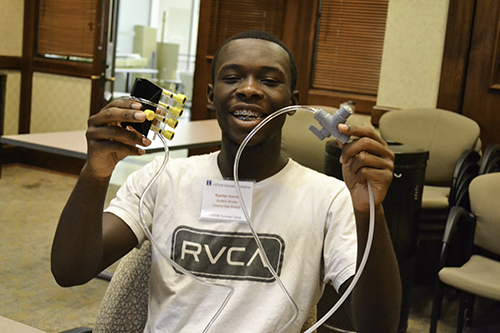
An Urbana High athlete shows off a completed design
A 24-year-old woman, Magdalena, who had bone cancer as a child and thus had an arm amputated needs a prosthetic in order to maintain her livelihood. This was the scenario presented to 27 Urbana High School (UHS) student athletes as a part of MechSE Day on Thursday, August 17, during I-STEM’s first-ever multidisciplinary summer camp. So the day’s main hands-on activity involved making a prosthetic device. And while the students learned a bit about prosthetics and Mechanical Engineering during the day’s events, they also learned some things about teamwork and what being a MechSE undergrad might be like.
Sharing their expertise on MechSE Day was a team of professors and students from MechSE, including Associate Professor Elif Ertekin, Assistant Professor Mariana Kersh, and MechSE grad students John Shanley and Kazem Alidoost, who shared about current research in their field and the elements that go into making prosthetics. Then the high school students got a chance to make one of their own. And, knowing that a good competition will always spur students on to greater achievement, the MechSE instructors divided the students into teams and made the activity a competition to see who could make the best prosthetic arm. The challenge? Design and build an arm for an amputee that operated using pressurized air from an air tank and included a hand with fingers that could pick up a pair of sunglasses…all in the shortest amount of time possible.

MechSE grad student, John Shanley, presents the challenge and its materials to I-STEM campers.
Embracing the challenge, students tackled the project. Of course, they thoroughly enjoyed the fun of competing. And while doing so, they also learned a bit about the thought processes behind designing prosthetics. While working the kinks out of their design, the UHS students tried many different approaches (some worked, and others didn’t), to design and build a working prosthetic. But if and when the teams reached an impasse, luckily, the instructors, who were knowledgeable about mechanics of prosthetics, were right in the classroom with them, so students were able to pick their brains regarding what might make their devices work better. As a result, most of the teams came up with some innovative, working prosthetic arms.
What’s the point of exposing younger students to a one-day clinic on prosthetics? According to MechSE’s Mariana Kersh, it’s beneficial to bring high school students to events like this on campus in order to expose them to engineering. “Depending upon where they're coming from, they may or may not have been exposed to the applications that are available within engineering. It has to start early.”
She adds that it’s also important that students at the high school level learn that engineering is “a really broad and interdisciplinary world these days.” Plus, she believes that exposing young people to the myriad applications and career opportunities within the different engineering disciplines (such as prosthetics?) might increase the number of students, especially young women, who want to be involved. She recommends starting early to show younger students, especially girls, “that there are other options other than just the typical guy working on an airplane.”
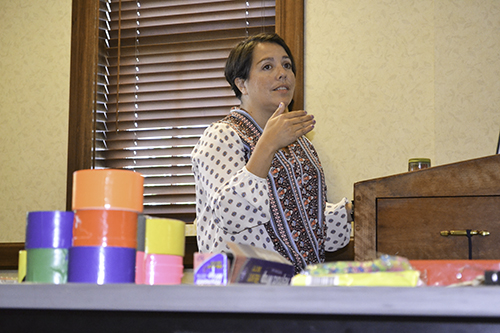
Assistant Professor Mariana Kersh speaks to the I-STEM campers during their tour
Kersh says events like the camp also serve as a “light at the end of the tunnel” and help students “learn that there is this bigger picture.”
She says that high school students “have to come in with a bit of passion and a bit of curiosity and inspiration about the things that they want to study. A lot of them may know that they're good in math or that they like science, but they don't really know where that's going to take them,” she continues. Kersh envisions the event as helping to show them the possible routes early, and helping to keep them on track.
Plus, she insists that in order for students to avoid pitfalls and successfully navigate college with its ups and downs, they need to have a clear vision of what they want to achieve, and why. She believes that having the goal of helping others as part of their motivation can help to keep students anchored. “It's not about the degree per se,” she says, “it's about what you're going to do with it in order to help” that can help them to get through distractions and getting discouraged when they don't do well on a test, because they’ve learned that ‘There’s this bigger picture that I really learned about, and that's what is driving me.’ It's hard to have that vision as an 18-year old,” she admits.
MechSE grad student John Shanley agrees with Kersh that it’s beneficial to bring high school students onto campus to events like the camp to familiarize them with the possibilities open to them: “It's great to open their eyes up to the opportunities that are out there.”
According to Shanley, he volunteered for I-STEM’s camp because he’d done activities similar to this one during eight different camps this past summer, admitting, “So it's kind of a natural fit to continue on with it.”
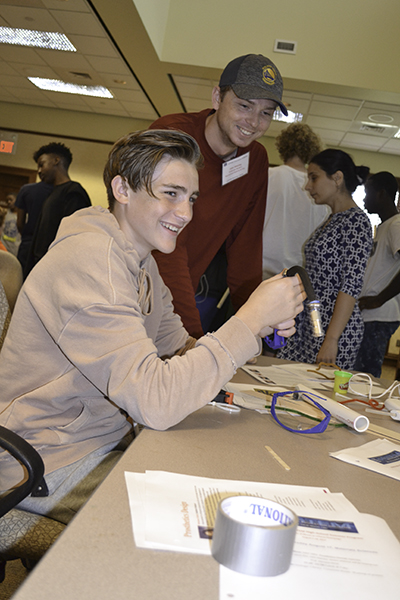
MechSE grad student, John Shanley, watches on as a UHS student works through the Prosthetic Device competition.
Plus, he enjoys giving high school students opportunities he wishes he had had when he was their age. “I had no idea what biomechanics was,” he recalls. “I was someone who knew that I wanted to be an engineer, and I still didn't know about it. It's great to see what opportunities are out there, especially for people like myself a few years ago who don't know what the options are. I was good at math, and I didn't know what to do with that. Well, this is one of the applications that you can have, so it's a good start.”
Shanley intends to go into industry in bioengineering once he completes his Masters' degree. His goal is to work for a company that makes devices that help people and improves the quality of their lives. “First, I just like the idea of being able to help someone and secondly, and I think it's the industry with the most interesting problems. You can go ahead and continue to optimize things that people have been working on for centuries now, like mechanical engines and systems like that, and there are people making real break-throughs there too, and that's cool. But there's so many different problems, and there's such a diversity of places that you can apply your skills to really make a difference, and I just think that there's a greater amount of opportunity there and that's just exciting to me.”
Kazem Alidoost, a fifth year MechSE PhD student, who would like to go into academia once he gets his degree, has been involved with the Mech-E summer camp for two years. Plus, this past spring, he took ENG 599 with Professor Ertekin, Sharlene Denos, Joe Muskin, and others, and was really impacted. “That was just a really great class,” he acknowledges. “I think I'll take it again this next spring just to go back to the high school, because I think we spent a lot of time talking about how important outreach is and the beneficial effects that it can have.”
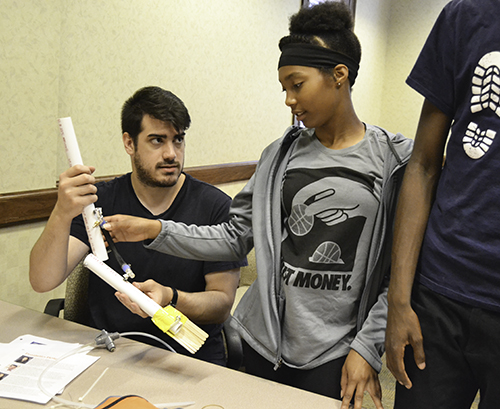
Kazem Alidoost, a fifth year MechSE PhD student, coaches a camper through prosthetic design
He was involved in outreach in his own community where he grew up, but now would like to make a difference here too. “I think it's important to try to make an impact where you are and identify with your current community.”
Alidoost also praises the Illinois faculty and students who volunteer for the various outreach programs, saying, “I think having students and faculty here at Illinois who do this because they care means a lot to the people.”
Alidoost shares why he think it’s important to bring high school kids onto campus for outreach events like I-STEM’s camp.
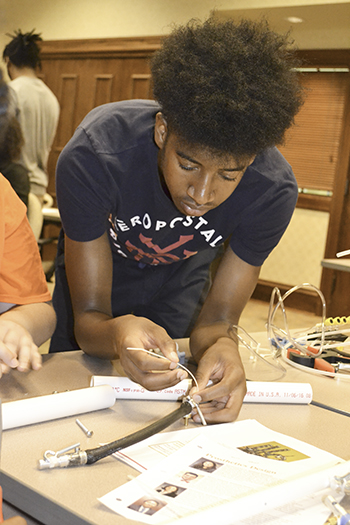
A UHS student athlete works on his team's prosthetic.
“Growing up,” he acknowledges, “my parents were always talking about going to college and studying engineering or medicine, and so I think for me, it was always a natural thing.”
He lived next to a college growing up, so he was familiar with the facilities. But since coming to Illinois to school, he’s discovered that most of the people he’s met were not that fortunate. “So I think it's just important to bring people so they can see what's out there,” he says.
He also believes activities like I-STEM's camp are good because they make youngsters comfortable and show them that they too can do STEM.
“They feel like they can come here, and they see that they are capable, and that they can do it. Just to show that everything is accessible to them, that we want them here, and that they can accomplish whatever they want.”
Similarly, Assistant Professor Elif Ertekin hopes to help the students see themselves here, doing what she and the others are doing. “I think that being involved in camp activities and getting other people excited about what it is that we do what we do and showing younger students who will be next generation engineers what we do so that they can start to imagine themselves also there and doing the same thing, is really important and valuable.”
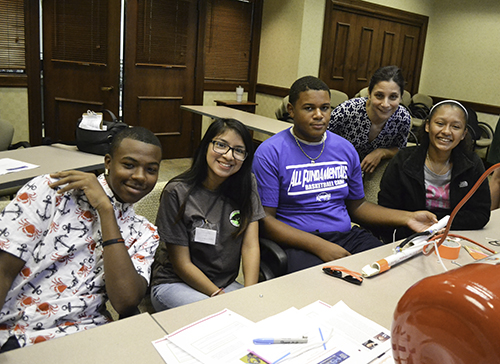
Ertekin poses with the team that won the Prosthetic Device competition.
And according to Ertekin, that was one of her main goals in doing the camp—to help the high school students see themselves doing engineering. “A lot of the modern research shows that in order to be able to choose a certain career path, you have to be able to envision yourself being that person and doing that job in the future. So right now, by trying to give the young people hands-on experience, working directly with graduate student researchers and faculty, I think that really helps them imagine themselves doing this as a part of their careers in the future.”
Ertekin adds that she also likes to do activities like the I-STEM camp because they help her remember why she fell in love with engineering in the first place.
“I do things like this because I think it's really important to remember the big picture of the work that we're doing in our day-to-day research. When you are doing research all the time, it's easy to sometimes forget why we got involved in the work that we're doing.”
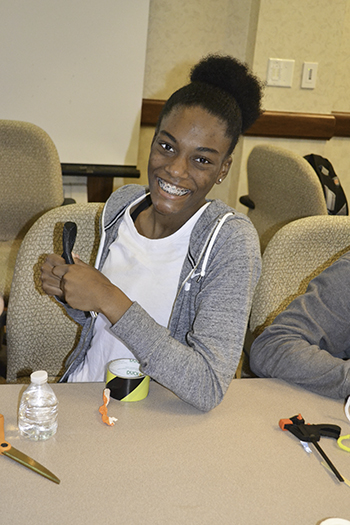
An I-STEM camper grins in antcipation of the challenge ahead.
Author/Photographer: Elizabeth Innes, Communications Specialist, I-STEM Education Initiative
More: 8-12 Outreach, I-STEM Initiatives, MechSE, STEM Pipeline, Summer Camp, Underserved Students/Minorities in STEM, Urbana High School, 2017
For additional articles about I-STEM's 2017 Summer Camp, see:
- I-STEM Multidisciplinary Summer Program Exposes UHS Athletes to Different STEM Departments/Units
- MCBees Use “Whodunit?” to Pique UHS Students’ Interest in Science During I-STEM Summer Camp
- MNTL Day Exposes UHS Students to Nanotechnology Research During I-STEM’s Summer Multidisciplinary Camp
- Akono and Company Teach UHS Students About Civil Engineering and Strength of Materials During I-STEM’s Multidisciplinary Summer Camp
- ECE Day at I-STEM’s Multidisciplinary Summer Camp: Soldering, Circuits, and Software
- Math Day at I-STEM’s Multidisciplinary Summer Camp Adds Up to Fun
- During I-STEM Summer Camp, Urbana High School Students’ Understanding of Aerospace Engineering Soars
- UHS Students Explore Computer Science, Coding, During I-STEM Camp’s CS Day
- At I-STEM's Multidisciplinary Summer Camp, UHS Students Have Fun with Chemistry—Everything From Soap Making To Glow Sticks to Ice Cream
- During I-STEM Camp’s NCSA Day, UHS Students Experience Data Visualization, Super Computers, and NCSA’s Research

Elif Ertekin watches as an UHS student works on his team's prosthetic.













.jpg)
















